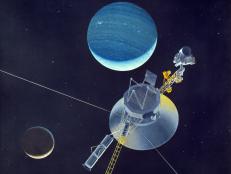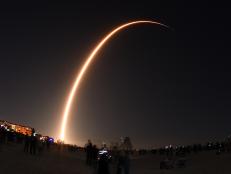All Space Articles
Showing 91 - 105 of 490 results
Water Molecules Found on Sunlit Surface of the Moon!
Breaking News! At 12P ET today, October 26, NASA announced a new discovery about the Moon. Here are the agency’s findings resulting from the world’s largest airborne observatory, SOFIA.
India’s Space Agency is Going Big… By Going Small
Astrophysicist Paul M. Sutter shares the latest in the world of rocket launches and what India’s SSLV is all about.
How Common are Water Worlds in the Galaxy?
If Kevin Costner wanted to make a sequel, he’s got plenty of opportunities. Water is by far the most common molecule in the universe. It’s made of two parts hydrogen and one part oxygen. Hydrogen is element number 1 (both on the period table and in abundance), and has been hanging around since the first 15 minutes of the Big Bang. Oxygen is forged in the hearts of sun-like stars, and spreads around when those stars die and turn themselves inside out. And since sun-like stars are also very popular, oxygen gets quite a boost.
Celebrate the I Heart Pluto Festival, An Ode to the Beloved Planet
Yes, we said "planet." Clyde Tombaugh discovered Pluto at Lowell Observatory in Flagstaff, Arizona during the month of February in 1930.Last year on the 90th Anniversary of the discovery, the observatory held its first I Heart Pluto Festival. This year you can be a part of the action.
Expedition 63 to Return Home on October 21
After 196 days in space aboard the ISS, NASA astronaut Chris Cassidy, Roscosmos cosmonaut Anatoli Ivanishin, and Roscosmos cosmonaut Ivan Vagner are coming home! Let’s learn the details of their return to Earth.
Check Out NASA’s DART Mission
It’s like “Armageddon” but in real life.
Voyager 2 is Really Far Out There, Man
Currently Voyager 2 is about 11 billion miles from the Earth, and has been traveling at speeds of tens of thousands of miles per hour since its launch in 1977. Read more to see where it is now and what we've learned.
SpaceX Test Flight Ends in Explosion
An experimental rocket launched by SpaceX on Wednesday, December 9 exploded after launching 8 miles into the air. Elon Musk says that this test was still a success.
NASA’s $10 Billion Space Telescope Hit by Micrometeoroid
NASA’s new James Webb Space Telescope (JWST) was recently hit by a micrometeoroid. One of the 18 golden mirror segments on the telescope was hit, causing some minor damage.
Jupiter Makes Its Closest Approach to Earth in Nearly 60 Years
The last time Jupiter appeared this large and bright in the sky was in October 1963.
SpaceX vs. the Universe
Fans of space are having a tough time picking sides over a recent controversy between SpaceX and astronomers. But what's the big debate all about? Astrophysicist Paul M. Sutter digs into both perspectives.
2020: A Year of Big Leaps for Mankind
Here are a variety of some amazing space launches to look forward to in 2020.
28 Billion Light-Years Away: The Most Distant Star Ever Discovered
On Wednesday, NASA announced the Hubble telescope broke a new record– detecting the most distant star ever seen.
NASA’s Plan for Returning to the Moon
NASA is planning to land the first woman and next man on the moon in 2024. Through a US government-funded human spaceflight program known as Artemis, there may be human footprints on the south pole region of the lunar surface in the very near future. From understanding the Artemis Program to the Gateway, let’s explore the lunar details.
Meet WASP-127b, the Fluffiest Planet in the Galaxy
Take a planet with the mass of, say, Saturn. You know, pretty big, but not ridiculously big. Just…normal big.























